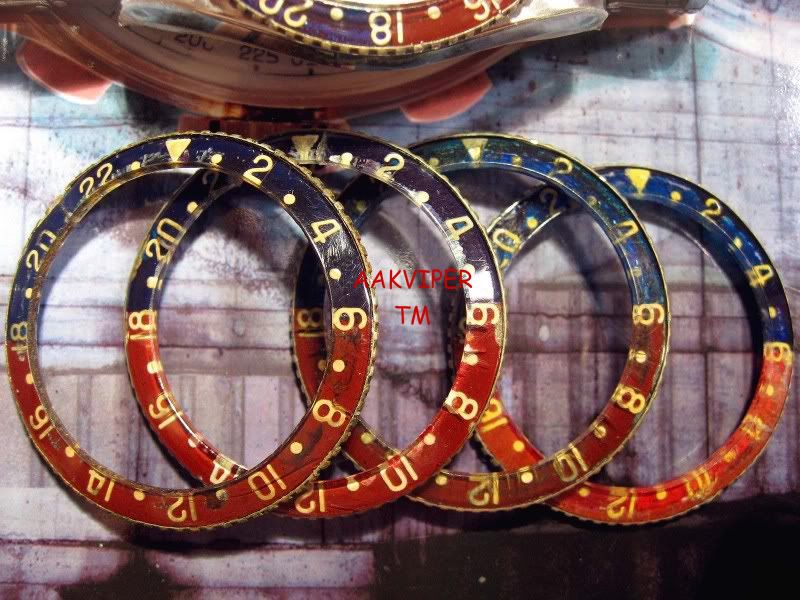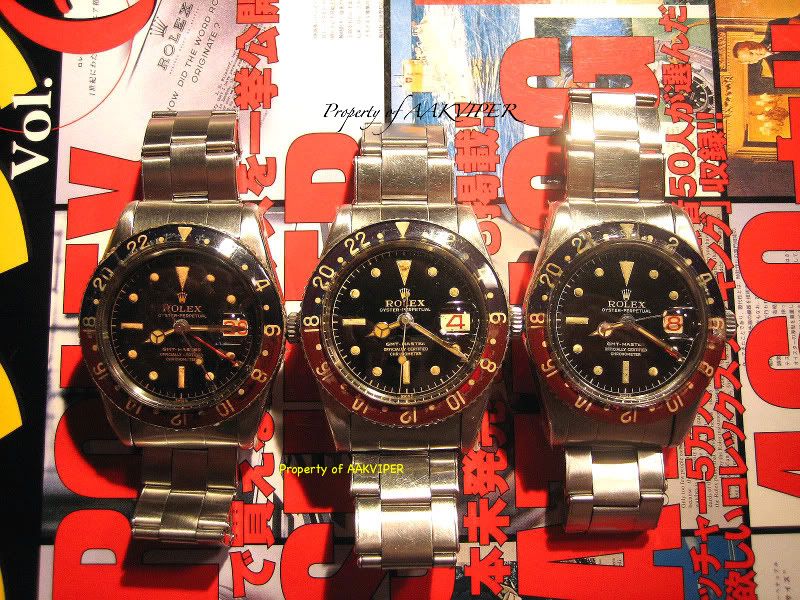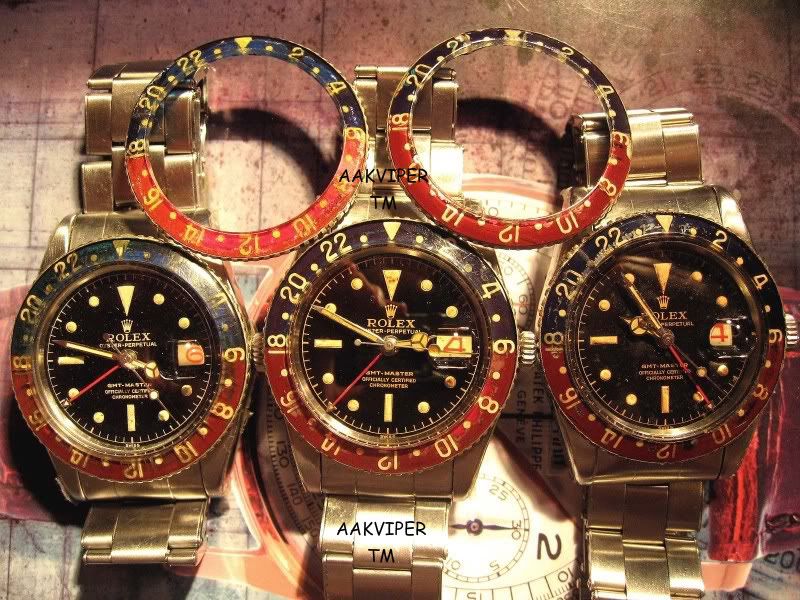

The reference model 6542 GMT Bakelite is my favorite variation from the GMT line. The famous Bakelite bezel was made from an acrylic type of material called Bakelite that had a terrible shortcoming in it's design. Rolex used this plastic or acrylic material because it was easy to mold into many forms by heating. Acrylic found it's way into industry utilization in the early 1930's in kitchen appliances and were engineers need a light material to replace clay or light metal.
A Bakelite product did crack with hard hits or when dropped severely.
In retrospect it was a bad idea to design a watch bezel for a sport's watch which took most of it's initial hits from hard activities. But it was easy to work with and this plastic was the only means to add radium to the numbers. I also suspect that it a cheaper product then metal.
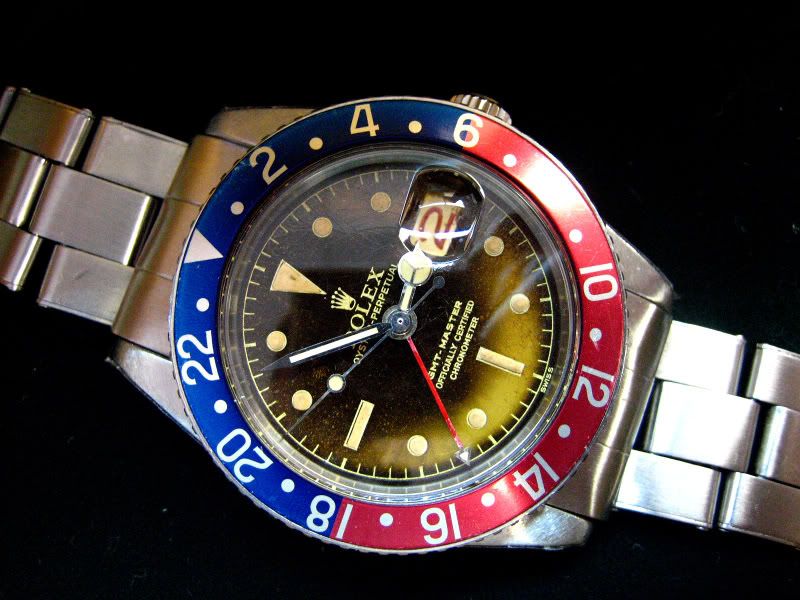
From what I observed the design looks to be of a double inlay process. A base was made in a mold then the numbers were added by a die which pressed these numbers onto the base. Then the famous slightly radioactive radium material was applied to the numbers and a top acrylic coat was added and pressed together and baked by heat.
The result, was a fantastic glistening looking bezel in which the numbers glowed in the dark.
To this day many true Bakelite bezel's numbers still glow in the dark.
When one looks at a Bakelite bezel you get the appearance that the numbers are suspended in the bezel. That is because of the double inlay method that the manufacture used. It was a very ingenious method that Rolex used, but unfortunately this concept of the GMT bezel numbers glowing in the dark as do the dial markers and hands, never was manufactured again and was discontinued with the 6542 GMT model. Most Bakelite bezels were replaced with the more sturdy flat in appearance metallic version.
The problem that faced the Bakelite GMT bezel was that some how a radiation scare transpired regarding this Bakelite radium filled numbers GMT bezel. My guess that in the 1950's with the advent of the atomic bomb, the world population was on radiation fear alert. This fear compounded onto the bezel being retroactive and detrimental to the person wearing the GMT watch model. Rolex sent out reassurance letters to customers that these bezels where safe, and even offered to change to a new metal type of bezel.
To compound to the Bakelite bezel troubles, a pattern of cracking and paint fading started to occur on parts of the Bakelite bezel because of bezel tension stress from heat temperature differential and improper bezel removal at service. Many cracked Bakelite bezels started to appear after a service because of the side deflection and stress from the bezel removing tool used to pull the bezel from the crystal retaining ring. The tenacious grip from the inlayed thin wire on the inside track of the bezel to the crystal retaining would cause an imminent crack to parts of the bezel. Sometimes no matter what a watchmaker did the only way to remove a Bakelite bezel from the crystal retaining was to apply so much pressure on the bezel removal tool that a crack was bound to occur and unavoidable.
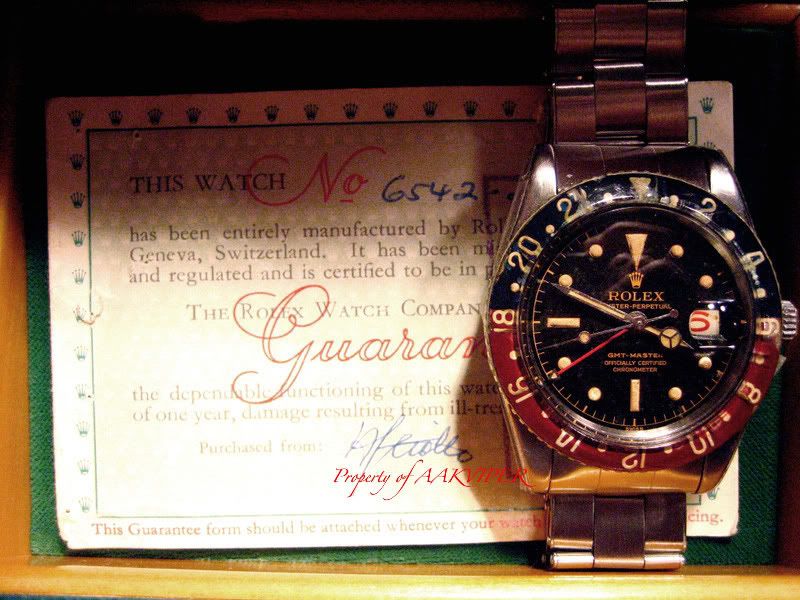
I believe that from the year 1955 to the late 1950's every 6542 GMT was outfitted with a true Bakelite bezel and a red and black roulette type date wheel. A short production run of four years and a quite recall by Rolex makes this Bakelite bezel even more rare to find in any condition. These early Bakelite GMT'S are truly an important piece of Rolex history. Sadly not many Bakelite bezels survived the test of time.
I am genuinely lucky to own a piece of Rolex GMT history.
A Bakelite product did crack with hard hits or when dropped severely.
In retrospect it was a bad idea to design a watch bezel for a sport's watch which took most of it's initial hits from hard activities. But it was easy to work with and this plastic was the only means to add radium to the numbers. I also suspect that it a cheaper product then metal.

From what I observed the design looks to be of a double inlay process. A base was made in a mold then the numbers were added by a die which pressed these numbers onto the base. Then the famous slightly radioactive radium material was applied to the numbers and a top acrylic coat was added and pressed together and baked by heat.
The result, was a fantastic glistening looking bezel in which the numbers glowed in the dark.
To this day many true Bakelite bezel's numbers still glow in the dark.
When one looks at a Bakelite bezel you get the appearance that the numbers are suspended in the bezel. That is because of the double inlay method that the manufacture used. It was a very ingenious method that Rolex used, but unfortunately this concept of the GMT bezel numbers glowing in the dark as do the dial markers and hands, never was manufactured again and was discontinued with the 6542 GMT model. Most Bakelite bezels were replaced with the more sturdy flat in appearance metallic version.
The problem that faced the Bakelite GMT bezel was that some how a radiation scare transpired regarding this Bakelite radium filled numbers GMT bezel. My guess that in the 1950's with the advent of the atomic bomb, the world population was on radiation fear alert. This fear compounded onto the bezel being retroactive and detrimental to the person wearing the GMT watch model. Rolex sent out reassurance letters to customers that these bezels where safe, and even offered to change to a new metal type of bezel.
To compound to the Bakelite bezel troubles, a pattern of cracking and paint fading started to occur on parts of the Bakelite bezel because of bezel tension stress from heat temperature differential and improper bezel removal at service. Many cracked Bakelite bezels started to appear after a service because of the side deflection and stress from the bezel removing tool used to pull the bezel from the crystal retaining ring. The tenacious grip from the inlayed thin wire on the inside track of the bezel to the crystal retaining would cause an imminent crack to parts of the bezel. Sometimes no matter what a watchmaker did the only way to remove a Bakelite bezel from the crystal retaining was to apply so much pressure on the bezel removal tool that a crack was bound to occur and unavoidable.

I believe that from the year 1955 to the late 1950's every 6542 GMT was outfitted with a true Bakelite bezel and a red and black roulette type date wheel. A short production run of four years and a quite recall by Rolex makes this Bakelite bezel even more rare to find in any condition. These early Bakelite GMT'S are truly an important piece of Rolex history. Sadly not many Bakelite bezels survived the test of time.
I am genuinely lucky to own a piece of Rolex GMT history.
